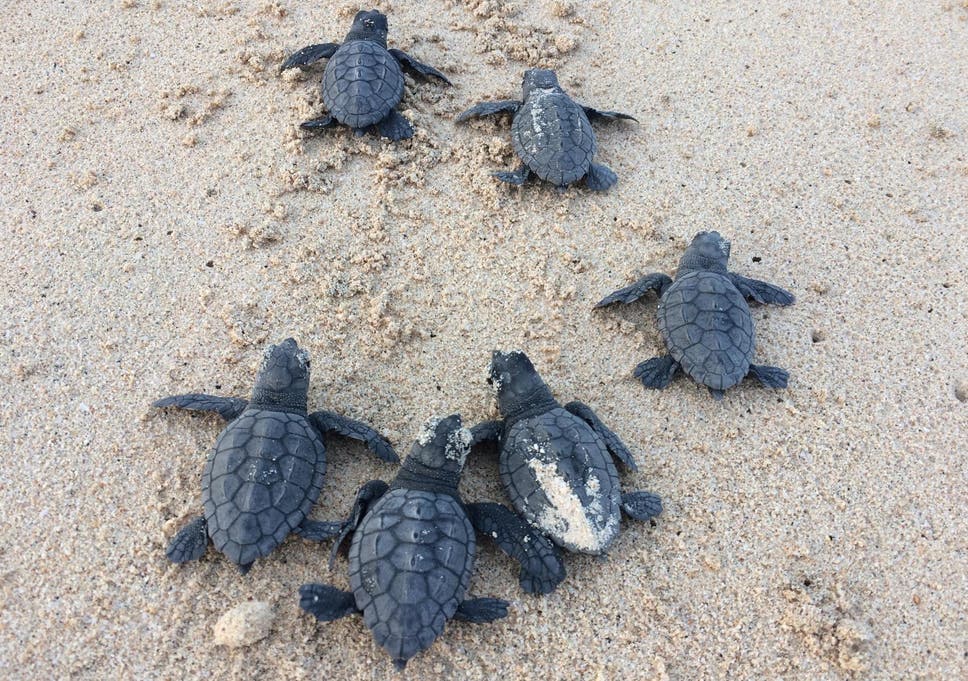Sex Sensitivities of Loggerhead Turtles
"One hundred percent girls. This nest will be 100 percent girls."
"Males here could vanish in two or three decades. There will be no reproduction."
Adolfo Marco Llorente, Spanish researcher
"Cape Verde hosts one of the largest nesting population of loggerhead turtles in the world -- up to 15% of the global nesting total."
"We estimate that 84% of current hatchlings are female, and warmer temperatures will increase this proportion."
"Under all three climate change scenarios in our study, by 2100 more than 99% of hatchlings would be female -- and under mid- and high-emissions scenarios there could be no males at all."
Dr Lucy Hawkes, University of Exeter
 |
| 90 per cent are on track to be killed by ‘lethally high temperatures’ before hatching ( Lucy Hawkes ) |
These are animals whose lifespan is long, equalling that of humans -- where turtles living for up to 100 years will over their lifetime lay over one thousand eggs. Sea turtles don't mate for life as some other species of animals do; one male is able to find plentiful sexual partners; polyamorous in their sexual behaviour.
 |
Turtle hatchlings' global future is now one of great uncertainty, for as Earth becomes warmer worldwide hatchlings are modelled to cant toward the female of the species, making turtles an early-warning signal for climate change. On Cape Verde, a tiny island in West Africa, a sixth of the planet's nestling loggerhead turtles already displays a wide disparity in turtle hatchlings' sex.
Researchers from the University of Exeter in Britain published a report in June indicating the increasing potential for these hatchlings to be of a single sex, in lock-step with a warming planet. A tenth of planet Earth has warmed past two degrees Celsius, the point where scientists assay that rising temperatures are able to bring along irreversible damage to ecosystems.
In Cape Verde, warming has been demonstrably above average at around 1.3C, since 1964, according to records kept at the island's primary airport. Researchers furthermore estimate that fewer than one percent of sea turtles at Cape Verde will be born male by the end of this century, and predict that more elevated temperature could conceivably see no more male hatchlings in the future.
The archipelago is highly dependent on tourism, its economy benefiting from the presence of approximately 30,000 sea turtles annually swimming to Cape Verde's environment to nest -- where 15 percent of the island's economic growth is dependent on the proceeds of tourism. "Turtles are the brand of Cape Verde", explained the country's assistant secretary of state for the maritime economy.
Profit from hotel taxes is used by the government of Cape Verde to pay for beach cleanups, for security meant to curb poacher activities and to build protective fences to hinder predators such as ghost crabs from feeding on the status-protected turtles. Non-profit groups work with the government in protection of the tourisn-dependent island turtles.
 |
Tourists, largely emanating from Europe, are brought by turtle guides on overnight beach treks. The guides are instructed by government to incorporate education about the turtles and the links to climate change as they lead these tours. "They see the turtles like toys. We have to tell them about the problems", explained Manuel Delgado Rodrigues, a tour guide.
It is well known that the environment is able to alter the gender of some lizards, crocodiles and species of sea turtles, but how and why this occurs is as yet unknown to scientists. Slight shifts in the land can affect their reproductive fate as well; the biological mechanism as elusive to science. But that hasn't stopped biologists from initiating ingenious efforts to cool the nests; digging up eggs to move them to shadier beach areas has been a success, as well as has sand-cooling sprinkler systems.
Additionallyl, dividing eggs into smaller units has been useful, given that too many eggs in tight spaces have the effect of warming their nests to an even greater degree.
 |
| About 85 per cent of loggerhead nests in Cape Verde are already laid on Boa Vista, where incubation temperatures are coolest but it is hoped the animals will adapt to mate at cooler times |
Labels: Biology, Cape Verde, Environment, Loggerhead Turtles, Warming Impact

0 Comments:
Post a Comment
<< Home